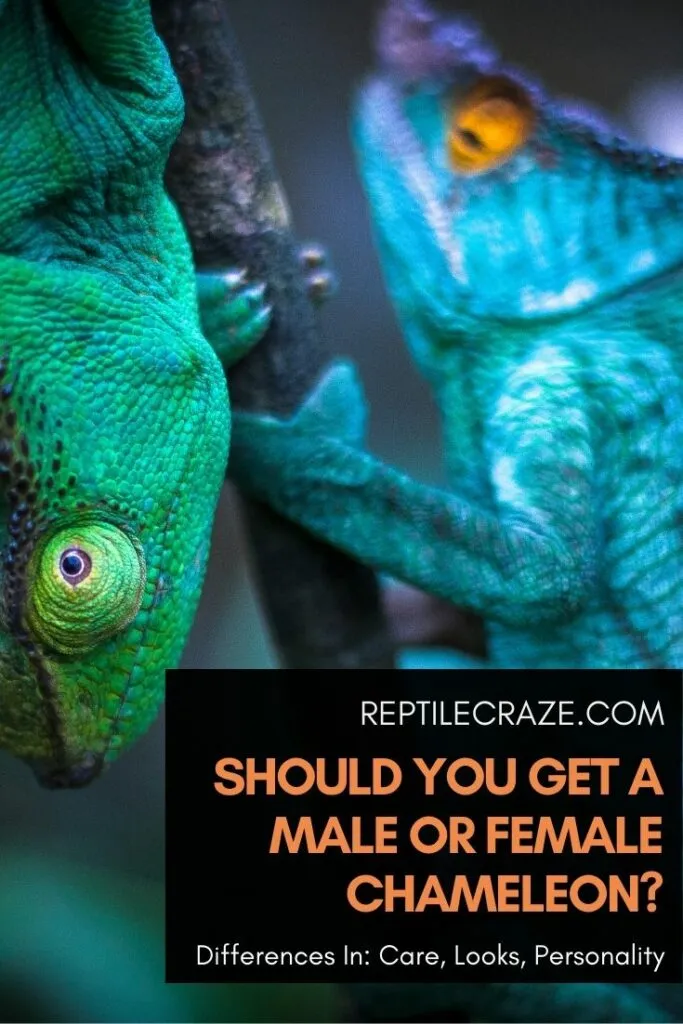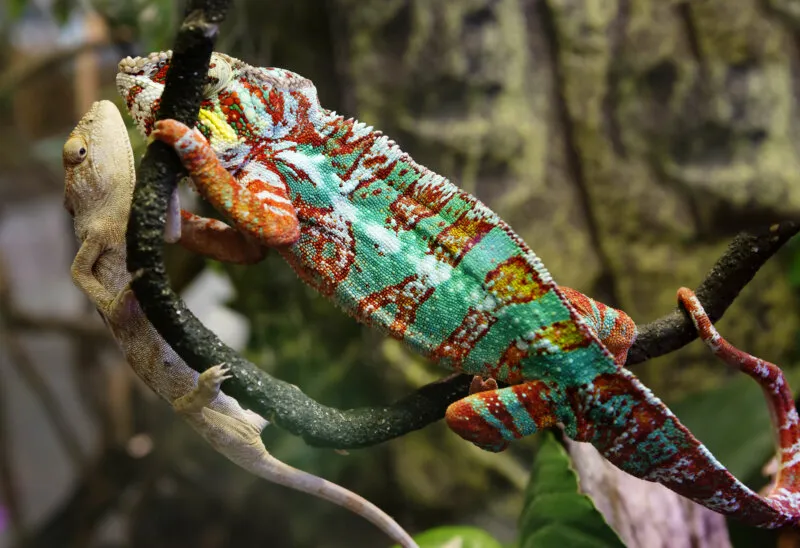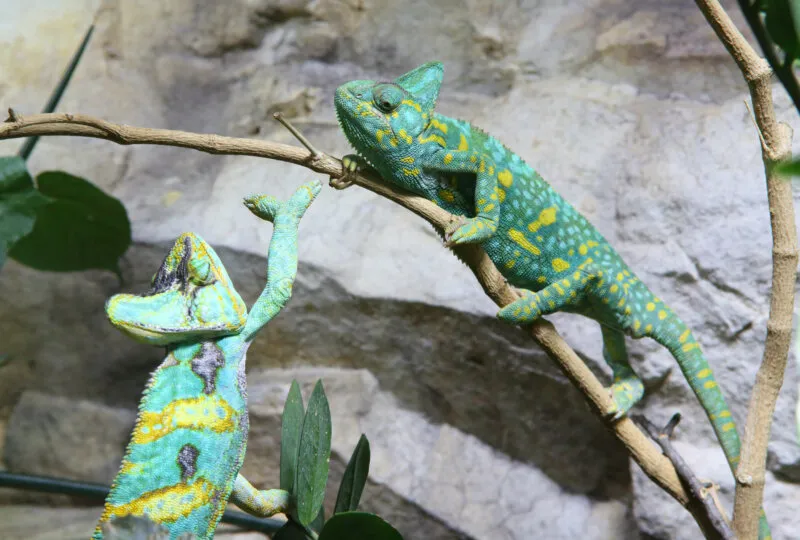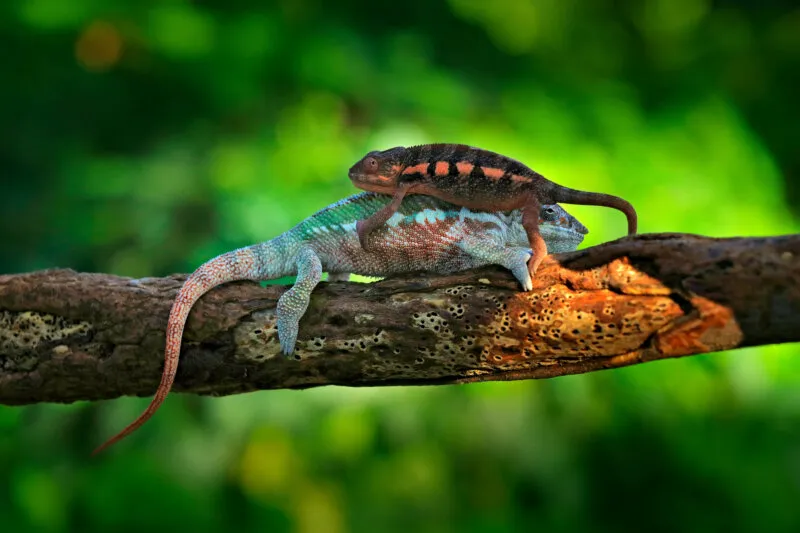
So you’re ready to get your chameleon? Congratulations! But first, you need to know whether a girl or boy chameleon would be better for you. Let’s find out what the differences are, and how they will affect you as a pet owner.
Male chameleons are larger, more aggressive, and have brighter colors. They have longer lifespans but are very prone to stress. Female chameleons are smaller and have duller colors. They are prone to medical issues such as egg-binding but are more placid and need less space.
Those are the basic facts, but there’s more to learn before you decide which gender will make the best pet for you.
Table of Contents
What Does It Matter If Your Chameleon Is Male Or Female?
It is important to know whether you should have a boy or girl chameleon for a number of reasons. Firstly, you want to give them a suitable name, and this is easier if you know the gender.
More importantly, however, is that male and female chameleons make quite different pets. In many ways, females are more difficult to provide appropriate care for.
This is because their egg-laying and birthing behaviors require special provisions, careful monitoring, and dietary restrictions.
Some owners shy away from the increased husbandry responsibility that comes with owning a female chameleon. Also, some owners are put off by the potential to have a less colorful pet (though I find the colors of the female Panther Chameleon to be very beautiful!).
On the other hand, while they are easier to keep medically healthy, male chameleons are challenging because they can become aggressive very easily.

They may show bright colors, hiss, and bite in response to the smallest changes. This is not good for their health as it causes stress. It also doesn’t make for the most enjoyable pet ownership experience!
Male chameleons, being so much larger, also require larger enclosures, more food, more misting, and higher temperatures. Females need less of all these and require cooler habitats. All these extras cost time, space, and money.
Let’s compare characteristics of the male and female chameleons from the 3 most common species that are kept as pets. These are Veiled Chameleons (Chamaeleo calyptratus), Panther Chameleons (Furcifer pardalis), and Jackson’s Chameleons (Trioceros jacksonii).
What Are The Differences Between Male And Female Veiled Chameleons (Chamaeleo calyptratus)?
Veiled Chameleons are the largest of the common pet chameleon species. The sexes can be told apart right after birth in most cases.
This is because males have a small bump or spur protruding backward from between the toes on the hind legs. Though females can sometimes have these too, it is generally a good indicator.
Around 5 months of age, the differences between males and females will become much more striking. The casque of the males will have grown much taller, upward of 3 inches sometimes.
Females still have a casque, but it is smaller. Males will also be much larger in general by this age.
Their colors will also be differentiated. Males will now be bright green, with some vertical golden, orange, and blue bars. Females will generally be a calmer mottled green all over. Of course, these colors can be different between individuals and varieties.

Around 4-6 months is also when female Veiled Chameleons might start laying their eggs. For this, it is important to provide her with a deep container of soft, moist earth to dig in.
If she can’t find a good place to bury her eggs, she will become very stressed and possibly quite ill.
Tip: Interested in getting a veiled chameleon? Our care guide (here) will teach you everything you need to know to take proper care of these amazing reptiles!
Managing egg-laying is quite complex. Even successful egg-laying takes a toll on the health of your female chameleon and will shorten her life span.
If egg-laying fails, and she becomes egg-bound, she may need surgical intervention. Experienced keepers can reduce these issues through careful temperature management, dietary restriction, and other care techniques.
Adult male and female Veiled Chameleons have very different temperaments. Males are territorial and quick to anger. It is important to keep males as calm and undisturbed as possible. Females are generally more placid, and easier to handle and build a relationship with.
Comparison Table – Veiled Chameleons (Chamaeleo calyptratus)
| Male | Female | |
| Can Tell Sex From… | Birth – 5 months. | Birth – 5 months. |
| Body Length | Longer and slimmer. 18-24in / 45-60cm | Shorter and wider. 12in / 30cm |
| Colors | Brighter & shown more often. Usually green with vertical golden bars, blue and orange. | Calmer & rarely shown. Usually a mottled green. (Vertical blue bars and yellow spots = in heat.) |
| Casque | Taller. Up to 3+ inches. | Shorter |
| Rostral Process (Long Nose) | No | No |
| Tarsal (Heel) Spurs | Yes | Not Usually |
| Hemipenal Bulge | Yes | No |
| Horns | No | No |
| Aggression Level | Higher | Lower |
| Life Span | 8-10 years | 5 years |
| Lays Eggs | No | Yes |
| Group Living | No | No |
| Habitat Needs | Needs larger space, higher temperature, more UV light and more misting. | Needs less space, cooler temperature, less UV light, less misting, but must be provided with a digging pot to bury eggs in. |
| Behavior | Territorial and aggressive towards other males. Shows bright colors when aggressive. Can bite and scratch often. Becomes stressed easily. | Not aggressive to other females. Shows colors to males, showing acceptance or non-acceptance. Much more relaxed and tolerant of people and handling. |
| Breeding Potential | Could earn a stud fee. | Opportunity to breed and sell chameleons. |
What Are The Differences Between Male And Female Panther Chameleons (Furcifer pardalis)?
Panther Chameleons are more difficult to tell apart during the first few months of their lives. However, a good and experienced breeder may be able to tell the sex right after birth as males have a color that is slightly kind of grey after birth and females are brown.
Still, the first indicator will be the presence (or lack) of a hemipenal bulge. This will be evident if you inspect the base of the tail, just below the vent. If the curvature is rounded and obtuse, it is probably a boy. If the tail is skinny, and the base of the tail is curved inward, then it’s probably a girl.
Around about 3 to 6 months of age, however, the strikingly different coloration of the male and female will become evident.
Male Panther Chameleons are extremely striking and come in a wide range of varied colors. Females, in my opinion, are equally beautiful and come in a range of pastel peaches, pinks, and neutral colors like brown.
The faces of adult male and female Panther Chameleons are also quite different.
Males develop a Rostral Process, which looks like a long ridge down the top of his nose area. Females, on the other hand, remain fairly smooth and rounded in the face.

Panther Chameleon females also lay eggs from the age of 6 months old (some earlier, some later, others never). Just as with the Veiled Chameleon, she will need to be provided with a deep substrate to dig and bury the clutch in.
As mentioned above, keeping your female chameleon as healthy as possible during egg-laying takes careful habitat control, close monitoring, and extra dietary considerations such as increased calcium supplementation.
Females are generally considered to be calmer and more relaxed pets, while males are prone to being very reactive.
Comparison Table – Panther Chameleons (Furcifer pardalis)
| Male | Female | |
| Can Tell Sex From… | 1 month – 6 months | 1 month – 6 months |
| Body Length | Longer and Bulkier. 12-18in / 30-45cm | Shorter and Lighter. 10-14in / 25-35cm |
| Colours | Bright colors of many variations. | Soft colors of peachy and neutral variations. (Bright pink=in heat. Bright orange with black=gravid) |
| Casque | No | No |
| Rostral Process (Long Nose) | Yes | No |
| Tarsal (Heel) Spurs | No | No |
| Hemipenal Bulge | Yes | No |
| Horns | No | No |
| Aggression Level | Higher | Lower |
| Life Span | 4-5 years | 2-3 years |
| Lays Eggs | No | Yes |
| Group Living | No | No |
| Habitat Needs | Needs larger space, higher temperature, more UV light and more misting. | Needs less space, cooler temperature, less UV light, less misting, but must be provided with a digging pot to bury eggs in. |
| Behavior | Territorial and aggressive towards other males. Shows bright colors when aggressive. | Not aggressive to other females. Shows colors to males, showing acceptance or nonacceptance. |
| Breeding Potential | Could earn a stud fee. | Opportunity to breed and sell chameleons. |
What Are The Differences Between Male And Female Jackson’s Chameleons (Trioceros jacksonii)?
Jackson’s Chameleons are pretty special and quite different from the others. For one, they are easily distinguishable from birth thanks to the horns on their faces.
Male Jackson’s Chameleons will have the beginning of 3 horns between their eyes and nostrils. Females will have none or one, just between the nostrils.
These chameleons are also much more similarly colored than their counterparts. Male and female Jackson’s chameleons are both quite a strong green.
Males are more likely to have patterning, and of course, show vivid colors more frequently as an aggression response, for exmple.

Interestingly, female Jackson’s Chameleons do not lay eggs! They are ovoviviparous, meaning that they make a type of egg membrane, and keep the eggs inside them until the young are ready to hatch.
At this time, she will lay the eggs so that they drop from a height. The fall triggers the babies to break out of the membrane, so they are essentially live-born!
Because of this, female Jackson’s Chameleons do not need a deep substrate for egg-laying. However, they still need special care and increased calcium in their diet.
There is still the potential for medical issues to arise, so close attention needs to be paid. The female also needs a high area to climb to in order to drop the eggs.
Male Jackson’s Chameleons can be very aggressive indeed. The horns on their heads are designed for fighting with other males.
The females are more placid, as with the other species. However, this is still considered to be a species that is better suited to an experienced keeper.
Comparison Table – Jackson’s Chameleons (Trioceros jacksonii)
| Male | Female | |
| Can Tell Sex From… | Soon after birth. | Soon after birth. |
| Body Length | Longer. 8-10in / 20-25cm | Shorter. 7-8in / 17-20cm |
| Colours | Brighter green but with patterns, including yellows and blues. | Green but less patterned. (Bright green= accepts mating) |
| Casque | Small. | Small. |
| Rostral Process (Long Nose) | No | No |
| Tarsal (Heel) Spurs | No | No |
| Hemipenal Bulge | Yes | No |
| Horns | 3 horns | No horns or 1 tiny horn |
| Life Span | 8-10 years | 5 years |
| Lays Eggs | No | No. Ovoviviparous. Eggs develop inside the mother and she appears to give live birth. |
| Group Living | No | No |
| Aggression Level | Higher | Lower |
| Habitat Needs | Needs larger space, higher temperature, more UV light, and more misting. | Needs less space, less misting. |
| Behavior | Territorial and very aggressive towards other males. Shows bright colors when aggressive. | Not aggressive to other females. Shows colors to males, showing acceptance or nonacceptance. |
| Breeding Potential | Could earn a stud fee. | Opportunity to breed and sell chameleons. |
Considerations Of Keeping A Male Vs Female Chameleon
Let’s compare some key factors that need to be considered when deciding on a boy or girl chameleon. Who will come out on top?
Cost
This is a difficult one to weigh up. Male chameleons need more food, use more energy in heating and lighting, use more foliage, etc. essentially they need more of everything and that adds up.
However, female chameleons are much more likely to need frequent vet visits. All that medical attention can cost a lot of money.
While this factor could swing either way, it is likely that keeping a female chameleon may cost more. Males are the winner.
Space
Males are larger, they need larger enclosures. They also are much more reactive, and you may end up with an individual that really needs some peace and quiet. For these reasons, males take up more space. In this round, females are the winner.

Friendliness
As a general rule (but not a guarantee), females of all the chameleon species we looked at today are calmer and more placid. They are less likely to be stressed by handling (as long as they are not gravid) and may make more enjoyable pets in this sense. The females win this round!
Life Span
Males have longer lifespans, of 10 years for Veiled and Jackson’s Chameleons, and 5 years for Panthers. Females have shorter lifespans of 2-6 years, thanks to the serious toll that egg-laying takes on their bodies.
It really depends on how long you want to commit to pet ownership, as to which is best for you. This round is a draw.
Colors
While this is again somewhat down to personal preference, most owners want a colorful and bright chameleon. The males are always more colorful, so for this round, males are the clear winners.
You Should Get A Female Chameleon If…
- You are an experienced reptile keeper.
- You are willing to pay out for frequent vet bills if necessary.
- You are prepared to provide proper care related to egg-laying.
- You want to breed baby chameleons.
- You would like to be able to handle your chameleon.
- You don’t mind them having less bright colors.
- You have other reptiles and they may be kept nearby.
- You want a pet for a shorter term of around 5 years.
- You want to call her Chamee-Leanne.
You Should Get A Male Chameleon If…
- You haven’t owned chameleons before.
- You really want him to be bright and colorful.
- You don’t mind him hissing at you.
- You don’t mind not handling him much.
- You don’t wish to breed baby chameleons.
- You have a lot of space.
- You are willing to buy a larger enclosure and provide more consumables.
- You want a pet for a longer term of around 8 years.
- You want to call him Chamee-Leon.
- Enchi Ball Python: A Unique and Stunning Morph of Python regius - March 27, 2025
- Emerald Tree Monitor: The Enigmatic Green Guardian of the Rainforest - March 26, 2025
- The Egyptian Cobra (Naja haje): A Fascinating Serpent - March 25, 2025
